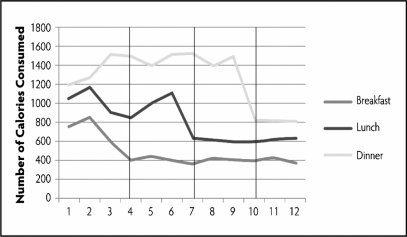Multiple Choice
Dr.Anderson is a nutritionist who helps clients lose weight prior to surgery.She is working with W.J. ,a male client who is planning on undergoing a heart transplant.He currently eats more than 3,500 calories a day and has been asked by his doctor to cut the number of calories to about 1,800 (400 for breakfast,600 for lunch,and 800 for dinner) .She is curious as to whether a food journal will help W.J.reduce the number of calories he eats.A food journal is used to record everything a person eats.Dr.Anderson decides to phase in the food journal gradually,initially only recording what is eaten at breakfast during the first three days after baseline (days 4-6) .During days 7-9,the journal is used at lunch,too,and during days 10-12,it also is used during dinner.Each day,Dr.Anderson's client sends her entries from the food journal and the number of calories he ate at each meal (as calculated by his wife,whose help she enlisted) .The data for Dr.Anderson's study are below.

-Dr.Natchez,a colleague of Dr.Anderson,questions whether W.J.simply wrote down less in his journal as the study went on because he grew tired of completing this "measure." Dr.Natchez believes he has uncovered which of the following threats to internal validity?
A) Instrumentation threat
B) Experimental demand
C) Testing threat
D) Observer bias
Correct Answer:

Verified
Correct Answer:
Verified
Q15: Which of the following is a within-groups
Q19: Which of the following designs has elements
Q39: Explain why quasi-experiments and correlational studies can
Q46: <br>Dr.Fletcher is interested in whether joining a
Q47: In conducting quasi-experimental designs,researchers tend to give
Q48: In small-N designs,each participant is treated:<br>A)With multiple
Q49: <br>Dr.Fletcher is interested in whether joining a
Q51: Which of the following can NOT typically
Q54: <br>Dr.Fletcher is interested in understanding whether joining
Q55: <br>Dr.Anderson is a nutritionist who helps clients